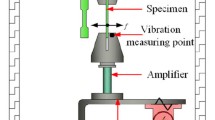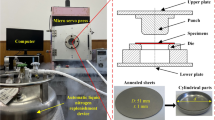Abstract
The high-frequency vibration technology was introduced to relieve the quenched residual stress in the Cr12MoV steel based on the high-frequency vibration system that mainly consisted of an electromagnetic vibrator and an amplitude boost unit. The high-frequency vibratory stress relief (VSR) experiments were conducted to study the effectiveness of the high-frequency vibration technology. In addition, the high-frequency vibration plasticity model was developed based on the thermal activation theory to reveal the mechanism of the high-frequency VSR. The results show that the high-frequency VSR has good effects on eliminating residual stress, while the surface hardness for the Cr12MoV steel remains almost the same. Moreover, there are no changes in the grain size of the Cr12MoV steel during the high-frequency VSR, while the dislocation density for the Cr12MoV steel during the high-frequency VSR decreases by 27.21%. The decrease of dislocation density in the Cr12MoV steel is the essence of residual stress relaxation. The findings confirm the significant effects of high-frequency vibration on metal plasticity and provide a basis to understand the underlying mechanism of the high-frequency VSR.











Similar content being viewed by others
References
R.T. McGoldrick and H.E. Saunders: Some experiments in stress-relieving castings and welded structures by vibration. J. Am. Soc. Naval Eng. 55 (4), 589 (1943).
C.A. Walker, A.J. Waddell, and D.J. Johnston: Vibratory stress relief-an investigation of the underlying process. Proc. Inst. Mech. Eng., Part E 209 (E1), 51 (1995).
M.C. Sun, Y.H. Sun, and R.K. Wang: The vibratory stress relief of a marine shafting of 35# bar steel. Mater. Lett. 58 (3–4), 299 (2004).
M.C. Sun, Y.H. Sun, and R.K. Wang: Vibratory stress relieving of welded sheet steels of low alloy high strength steel. Mater. Lett. 58 (7–8), 1396 (2004).
W. He, Y.X. Ren, C.J. Chen, and M. Fai: Analysis on technology of high-frequency vibratory stress relief. In Proceedings of the ASME Power Conference, Chicago, United States, 2005; pp. 119–122.
W. He, X.Y. Cheng, and R.J. Shen: Research on high-frequency vibratory stress relief for small assembly. In Proceedings of 1st IEEE International Conference on Nano Micro Engineered and Molecular Systems, Zhuhai, China, 2006; pp. 1428–1431.
J.W. Wang and W. He: Research on the technology of high frequency vibratory stress relief. Mach. Tool Hydraul. 9 (9), 9 (2005). (in Chinese).
W. He, B.P. Gu, J.Y. Zheng, and R.J. Shen: Research on high-frequency vibratory stress relief of small Cr12MoV quenched specimens. Appl. Mech. Mater. 157–158, 1157 (2012).
W.T. Thomson and M.D. Dahleh: Theory of Vibration with Applications, 5th ed. (Prentice Hall Publisher, New Jersey, USA, 1997); pp. 87, 182.
A.S.T.M. Standard: ASTM E 837-08 Standard Test Method for Determining Residual Stresses by the Hole-Drilling Strain-Gage Method (ASTM International, Pennsylvania, 2008).
M.R.H.T. Standard: GB/T 230.1-2004 Metallic Rockwell Hardness Test (Central Iron and Steel Research Institute, Beijing, 2004). (in Chinese).
P. Gay, P.B. Hirsch, and A. Kelly: The estimation of dislocation densities in metals from x-ray data. Acta Metall. 1 (3), 315 (1953).
S. Takebayashi, T. Kunieda, N. Yoshinaga, K. Ushioda, and S. Ogata: Comparison of the dislocation density in martensitic steels evaluated by some x-ray diffraction methods. ISIJ Int. 50 (6), 875 (2010).
T. Ungár: Dislocation densities, arrangements and character from x-ray diffraction experiments. Mater. Sci. Eng., A 309–310 (14–22), 14 (2001).
T. Shintani and Y. Murata: Evaluation of the dislocation density and dislocation character in cold rolled Type 304 steel determined by profile analysis of x-ray diffraction. Acta Mater. 59 (11), 4314 (2011).
G.K. Williamson, R.E. Smallman, and A.E.R.E. Harwell: Dislocation densities in some annealed and cold-worked metals from measurements on the x-ray debye-scherrer spectrum. Philos. Mag. 1, 34 (1956).
U.F. Kocks, A.S. Argon, and M.F. Ashby: Thermodynamics and Kinetics of Slip (Pergamon Press Ltd., Oxford, England, 1975); pp. 18, 19, 40, 105.
U.F. Kocks: Constitutive behavior based on crystal plasticity. In Unified Constitutive Equations for Creep and Plasticity, A.K. Miller ed.; Elsevier Science Publishing Co., Inc.: New York, USA, 1987; pp. 18–21, 23.
A.S. Argon: Strengthening Mechanisms in Crystal Plasticity (Oxford University Press Inc., New York, United States, 2008); pp. 32–44.
U.F. Kocks: Laws for work-hardening and low-temperature creep. J. Eng. Mater. Technol. 98 (1), 76 (1976).
X.F. Fang and W. Dahl: Strain hardening of steels at large strain deformation. Part I: Relationship between strain hardening and microstructures of b.c.c. steels. Mater. Sci. Eng., A 203 (1–2), 14 (1995).
Y. Estrin and H. Mecking: A unified phenomenological description of work hardening and creep based on one-parameter models. Acta Metall. 32 (1), 57 (1984).
ACKNOWLEDGMENTS
This research is sponsored by the high-tech research and development program of China (No. 2013A2041106) and the National Natural Science Foundation of China for Young Scholars (No. 51605303).
Author information
Authors and Affiliations
Corresponding author
Rights and permissions
About this article
Cite this article
Gu, Bp., Hu, X., Lai, Jt. et al. Effects of high-frequency vibration on quenched residual stress in Cr12MoV steel. Journal of Materials Research 31, 3588–3596 (2016). https://doi.org/10.1557/jmr.2016.378
Received:
Accepted:
Published:
Issue Date:
DOI: https://doi.org/10.1557/jmr.2016.378




